What is Email Marketing (Benefits, Metrics, & More)
On our blog, we aim to introduce our readers to all aspects of digital marketing and lay out all the basics of every strategy you might want to include in your marketing efforts.
Today, we’re going to talk about email marketing – one of the oldest and the most effective digital marketing strategies. We will discuss how it works, its benefits, the best tips to implement, and the most essential metrics to track.
Interested?
Let’s dive in!
What is Email Marketing?
Email marketing is a digital marketing strategy aimed to promote a product, service or share a certain update with a group of people via email messages.
Surely, this strategy is not new to the world. In fact, the first mass e-mailout was sent in 1978, and it was quite successful – the campaign brought its initiator $13 million worth of sales.
Is email marketing as effective today?
Despite the rise of other digital marketing strategies, like social media and online advertising, email marketing is still in demand. The number of email users worldwide is growing year by year and will reach 4,5 billion people by 2025. So, it gives businesses from different industries a chance to increase brand awareness, attract new leads, and improve sales.
What marketing objectives can you use emails for?
An email marketing campaign can take a wide variety of forms, but businesses of different sizes typically use emails for the following goals:
- To inform. In this case, we’re talking about email newsletters where companies provide niche, industry, and product updates. By the way, we have a great selection of newsletter examples, make sure to check it out.
- To generate leads. These emails attempt to attract potential customers by proving your product’s worth. The main focus is usually on showing how your product or service can tackle the different needs of your target audience.
- To nurture and retain. This category includes onboarding emails, personalized product recommendation messages and can also involve newsletters.
- To promote. Here, the task is to get more people to notice your new product or service or introduce the upcoming updates to the current version of your product to boost sales.
With the definition and goals clear, let’s move on to the process behind email marketing and try to review it in detail.
How Does Email Marketing Work?
An email marketing campaign might seem a challenge to set up, especially if you have a large email list to work with. However, it is not as complicated as it may seem at first glance. Let’s break it down step by step.
- Step #1: Choose an email service provider. Managing an email campaign manually would be very time-consuming, so you need an email automation tool that will do it for you. The SaaS market offers many email marketing software providers that can help you track metrics per campaign and email type. You might be tempted to use Internet Service Providers like Yahoo, Gmail, and Microsoft Outlook, to save money, but they offer limited bandwidth and email deliverability as these ISPs are only intended for personal use.
- Step #2: Upload your email list. This way, you will be able to send all emails automatically. The email marketing tool of your choice can also automatically expand your lead list if you connect it to pop-up forms or other lead magnets you use to generate prospects.
- Step #3: Create an email. Using design tools and templates your email marketing service provides, you can create a set of emails, schedule, and send them out to different target audience segments.
- Step #4: Do A/B testing. This practice is necessary to determine whether your email will bring the desired results.
- Step #5: Track the results. Before you send the emails, you need to set the email marketing KPIs you want to track when the campaign is launched. We will talk about them a bit later.
Yes, launching a successful email marketing campaign may seem a daunting task at first, but considering that your email marketing software will automate half of the tasks above, all you’ll have to do is keep an eye on the metrics and adjust your campaign accordingly.
Now, let’s quickly go over the benefits you can get when you have an effective email marketing strategy in place.
4 Benefits of Email Marketing
Like any other digital marketing strategy, email marketing requires ongoing investment. If you’re not sure it will cater to your expectations, here are some advantages of including emails in your regular marketing activities. We’ve also handpicked some interesting data to convince you.
Let’s dive in.
Benefit #1: More leads
As briefly mentioned above, you can use email marketing for lead generation. In fact, according to Snov.io with reference to Content Marketing Institute, 85% of companies use email as a medium to get new prospects.
Why are emails effective in generating leads?
When a new lead is picked up through a downloadable asset (a case study, checklist, an eBook, etc.), reaching out to the new prospect via email helps capture and retain them. As a result, you can unroll an entire email marketing campaign with the goal to:
- Generate more awareness
- Start building relationships with a prospect and nurture customer loyalty
- Increase your brand’s credibility
Such email campaigns are often ongoing, but when done right, they can help you not just expand your lead list and segregate relevant prospects from random passers-by but improve conversions and, as a result, boost sales.
But let’s not throw around empty claims and take a look at a real-life case study.
The F Company, which guides B2B brands through growth marketing, helped Praecom, a video conferencing solution from Finland, generate 13 times more B2B leads in just 5 months. After reframing the company’s target buyer persona, marketers launched a series of activities that helped target new customers. Lead capturing was done through ActiveCampaign, an email marketing tool, where the company tracked new subscribers and also launched a lead nurturing campaign. With the right activities to target leads, a nurturing campaign, and an effective lead scoring system, Praecom got 13 times more sales-ready leads.
Now, let’s take a look at how email marketing can help you generate brand awareness.
Benefit #2: Brand awareness
All digital marketing channels can help companies generate brand recognition and awareness. However, with email marketing, things are not as straightforward as, for instance, with social media marketing, where uploading a post and using a trendy hashtag can potentially get you noticed.
When it comes to email marketing, businesses usually work on increasing brand awareness among newly acquired leads by sending newsletters and company and product news. However, you can also try an outbound marketing method called cold emailing when you reach out to prospects who have little to no knowledge of your company and product.
How effective are cold emails?
We’re not going to lie – this approach can be quite invasive, but it still delivers solid results – the open rate benchmark for a cold email is 27%. This percentage is 10% higher than with opt-in emails.
Case studies also show that cold emailing is a rather effective way to increase brand awareness. Beazer Homes, a home building company, managed to reach 1,550 new prospects within a specific area after deploying 100,000 emails twice within a month. This campaign also helped the company drive more traffic to its website. Some of the new prospects even closed on homes from this developer.
Brand awareness is an objective that you always have to work on, no matter what strategy you use. With email marketing, you have to work on brand recognition among both new prospects and existing customers to ensure that the name of your company stays fixed in their minds.
However, brand awareness is cultivated not just through emails that tell subscribers about a company but also through offers providing a great level of personalization. Let’s take a look at how personalized email marketing content can help your brand achieve different goals.
Benefit #3: Personalized content
Email personalization involves using subscriber data to create email content based on their behaviors and preferences and make a special offer that caters to their individual needs.
How can personalized emails help you with different marketing goals?
Here’s what the statistics from Campaign Monitor show:
- 74%of marketers claim email personalization helps increase customer engagement.
- Promotional emails with personalized offers drive 6 times more sales.
- 53% of marketing specialists say ongoing email personalization efforts result in significant revenue impact.
- 50% of respondents say increasing personalization in an email brings an increase in open rates.
Email personalization is only possible after email list segmentation, which essentially means that you need to break down your entire subscriber list into smaller, more targeted groups. You can segment your list using the email marketing tool of your choice, but before you do that, you need to define the data points that will serve as the foundation for segmentation. We will discuss that a bit later.
If you do everything right, your efforts will pay off. According to the Campaign Monitor stats mentioned above, segmented lists can generate 58% of all revenue, and segmented campaigns can deliver a 760% increase in sales.
Now, over to our last benefit.
Benefit #4: Low cost
Email marketing is not as expensive as other digital marketing strategies (you can check out our analysis of social media marketing costs to compare). And it’s definitely not as expensive as online advertising can be – a bidding system PPC ads are based on can end up hitting your budget pretty hard.
So, how much do companies usually pay for email marketing?
WebFX, a well-known digital marketing agency, analyzed average email marketing costs and came to the conclusion that a mid-size business pays $9-$1,000 a month if it self-manages a campaign. Working with an agency can cost a business of the same size $300-$500 a month.
Indeed, these numbers are pretty much on point. If you choose to run a campaign by yourself through an email marketing platform, subscribing to it can cost you between $11 and $299 if you use Mailchimp, $9-$149 if you use ActiveCampaign, and up to $1,600 if you use MailerLite. These are just a few examples of email service providers to give you a general idea.
The final price for the email marketing platform subscription depends on the following factors:
- Number of subscribers on your list
- Number of emails sent
- Features available through a specific plan
So, if you’re a small business with no more than 1,000 subscribers, it won’t cost you much to run an email marketing campaign. However, the more email clients you get, the more extensive your campaigns will become, which will require more upkeep, and, as a result, incur higher costs. But it definitely won’t be something impossible to manage financially if your previous email campaigns bring revenue and new customers.
Email Marketing Tips to Implement
With all the email marketing benefits clear, let’s go through some actionable advice you can implement when either building your strategy from the bottom up or optimizing your current email marketing campaign.
Also, if it’s your first time launching a campaign and you have no point of reference, check out our selection of inspiring email marketing examples – it has use cases for every campaign goal.
Now, on to our tips!
Tip #1: Build your email list
An email list (electronic mailing list, subscriber list) is a data inventory containing email addresses for the distribution of any information. In our case, we’re talking about promotions and marketing campaigns.
To build an email list, you need to give a prospective lead an incentive to sign up. Brands usually ask potential subscribers to share their emails in exchange for something of high value to the prospects. This “something” is called a lead magnet – an item given away with the goal of obtaining customer contact details in return.
We’ve already mentioned here and there that you can share an eBook, a case study, or any other downloadable asset in return for the prospect’s email. It is usually done via a sign-up form. Here’s an example of original research from Hootsuite – if you want to get it, you’ll have to provide contact information first:
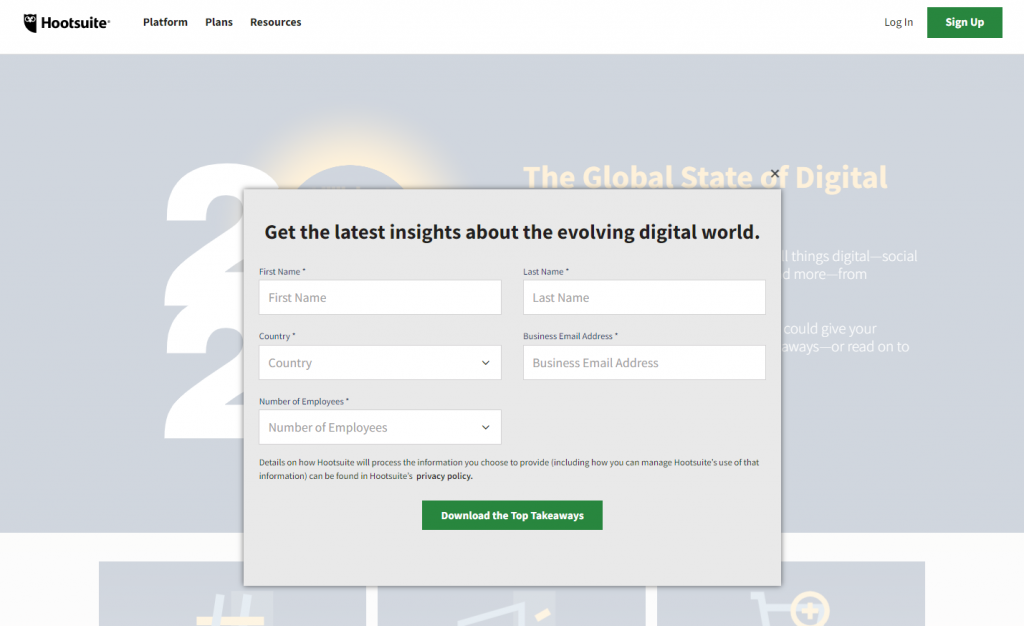
When you fill in the form and hit the CTA button to submit the details, the downloadable asset gets sent to your email or opens in a new tab.
Here are some options for such shareable content you can use to build up an email list:
- Cheat sheets
- Webinars
- Templates
- Coupons
- Demos
- Trials
- Product samples
- Toolkits
- Swipe files
- Quizzes
- Landing pages
To see examples of these content types and more, make sure to check out our article on lead magnets.
Is it legal to collect customer data this way?
Yes, it is, since the customer opts in to provide their personal information in exchange for something. It doesn’t contradict the CAN-SPAM Act and GDPR, but if you have second thoughts, you can include a disclaimer on the sign-up form. Here’s an example of such a disclaimer from Moosend:
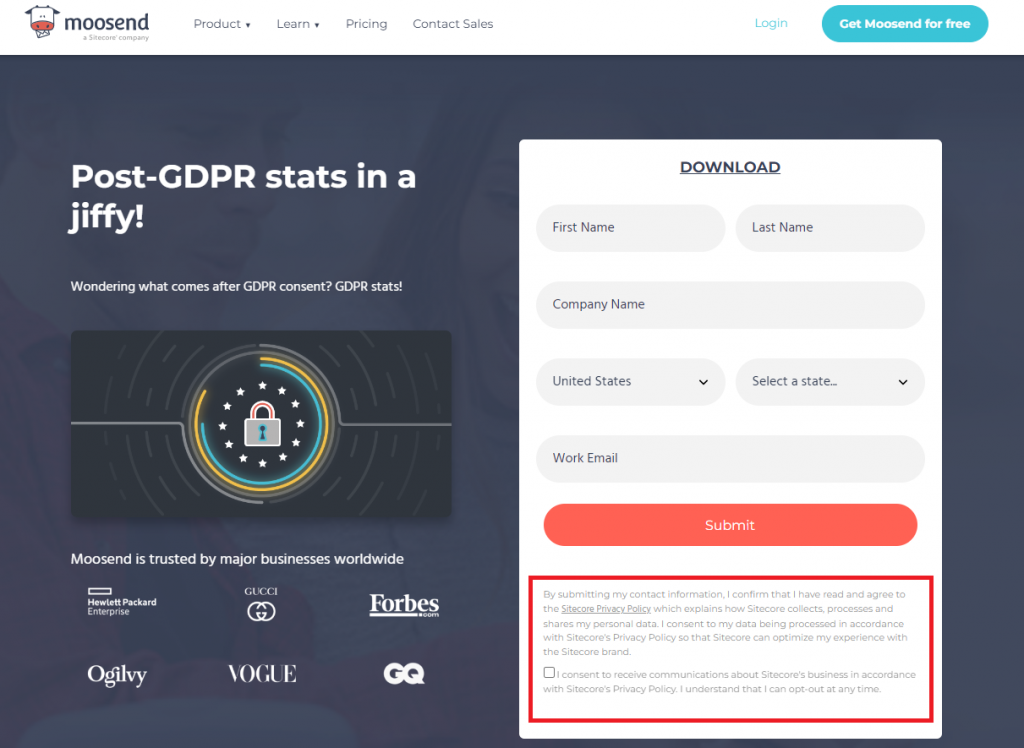
You can also add a concession agreement button for the new user to confirm they accept your terms.
Alright, suppose you have your email list now. What’s next?
Next, you segment it. Let’s go to the next section to see what this process entails.
Tip #2: Segment your email list
As mentioned earlier, email list segmentation presupposes breaking down your list of subscribers based on specific criteria. These criteria are not mandatory – you can choose the ones you deem necessary based on the goals of a specific campaign.
To do subscriber list segmentation, first, you need to select data points – they will serve as the basis for categorizing your subscribers into specific groups. These data points are usually based on:
- Demographics: age, gender, location, language, job title, industry, etc.
- Behaviors: previous purchases, the last time your email was opened, abandoned carts, whether you’re dealing with a free or paid user, how often a subscriber buys your product, and so on.
Using this data, you can break down your email list into larger or smaller groups. But, naturally, the smaller the group is, the more chances your email will have to resonate with the recipient, as the offer it provides will be more targeted.
Let us show you an example of a segmented email campaign. Let’s say there is a group of subscribers in your list that has abandoned products in a cart. By following the practice called email retargeting, you can pick up this behavior and target these subscribers with an abandoned cart email, like this one from Homes Alive:

Each abandoned cart email should be personalized, containing the products that a customer was about to buy but didn’t. Homes Alive also went further and added a contact form in case a customer had further questions about the products, their quality, and prices. All of this helps a consumer make a positive purchase decision. Similarly, you can launch more email series targeting other behaviors.
Of course, it will be hardly possible to collect all the subscriber data for proper segmentation if you don’t use a marketing automation tool. Let’s take a look at how to choose the right one for your needs in the next section.
Tip #3: Choose the right platform
You already know that an email marketing solution can automate 90% of all tasks related to email campaigns. All that’s left to you is tracking KPIs and metrics.
But how can you know that a certain email marketing tool is the right one for you?
You need to understand your current needs and resources. For instance, if you have an email list of 500 email subscribers and want to run a basic welcome email campaign, it won’t incur high costs, and you can even opt for a tool that has a forever free version (Mailchimp) or a free trial (ActiveCampaign). However, you also need to think about scalability, as your list will definitely keep expanding, so you should be able to adjust the email marketing software to your growing needs.
In general, we’d recommend looking for the following characteristics to find the best email marketing platform:
- Wide variety of features – it should include something as basic as autoresponders, follow-ups,transactional emails, and email templates, all the way to extended lead generation features.
- Ease of use – it shouldn’t take you too long to figure out how to navigate the features and workflows.
- Extended analytics capabilities – the more reports the software can generate, the better.
- A wide range of integrations with different tools and CRM – this is a must, especially if you’re using email marketing as a part of a larger campaign or doing email marketing for eCommerce.
- Reliability – the platform shouldn’t freeze and have bugs that could damage your data.
- Budget-friendly pricing – you should be able to find the pricing plan fit for your needs.
If you’re new to the world of email marketing and know nothing of such platforms, we’ve made a few comparison articles on Constant Contact vs. Mailchimp, MailerLite vs. Mailchimp, ActiveCampaign vs. Mailchimp, and SendGrid vs. Mailchimp – make sure to check them out.
Tip #4: Monitor the right metrics
Email marketing metrics (KPIs) are the indicators showing the success of your campaign. Tracking them is necessary to understand the progress and adjust your email marketing efforts if your campaign is underperforming.
What are the most common email marketing KPIs?
We will discuss them in detail later on, but let’s just list them for now to give you an idea:
- Click-through rate (CTR)
- Conversion rate
- Open rate
- List growth rate (LGR)
- Bounce rate
- Unsubscribe rate
You can monitor email metrics using the platforms mentioned in the previous section. They make it possible to set the most important KPIs you want to track for the particular campaign and generate reports on a daily or weekly basis.
How do you know you’re measuring the right metrics?
Every marketing guide would tell you that your choice of email KPIs should be based on your business goals and the goals of your campaign. In addition to that, you want to measure some email metrics, like spam complaint rate, unsubscribe rate, delivery rate, and bounce rate, on an ongoing basis – these metrics can indicate a problem with your email service provider.
Tip #5: Iterate
If you decide to dedicate a part of your budget to email marketing, be ready for the fact that it is an ongoing strategy, and you should monitor and work on it continuously.
Aside from monitoring the metrics, you’ll also have to clean your email list regularly. As time passes, some of the emails on your subscriber list may become irrelevant or outdated. As a result, the bounce rate of your emails may increase, which can impact your sender reputation. So, if you see no engagement from some subscribers for a long time and your re-engagement efforts don’t work, ditch them.
Another ongoing activity on your list will be A/B testing email subject lines and email copy. With this methodology, you basically create two versions of a subject line or content and send it to a target group of subscribers as a test. The one that performs the best will be used in your campaign. If you want to learn more about A/B testing, we described it along with other tips in our guide on email newsletter best practices.
Now, as promised, let’s go over the top email metrics to use in your campaign.
5 Email Marketing Metrics You Need to Know
As usual, the choice of metrics in any digital marketing strategy depends on the goals you set for it. Email marketing is no exception, however, there are some KPIs you’ll have to track continuously.
What are they?
Take a look.
P.S. If you want to learn about more email marketing metrics, make sure to check this guide.
Metric #1: Open rate
Email open rate is the percentage of subscribers who have opened a particular email out of all subscribers in your list.
Here is the formula for it:
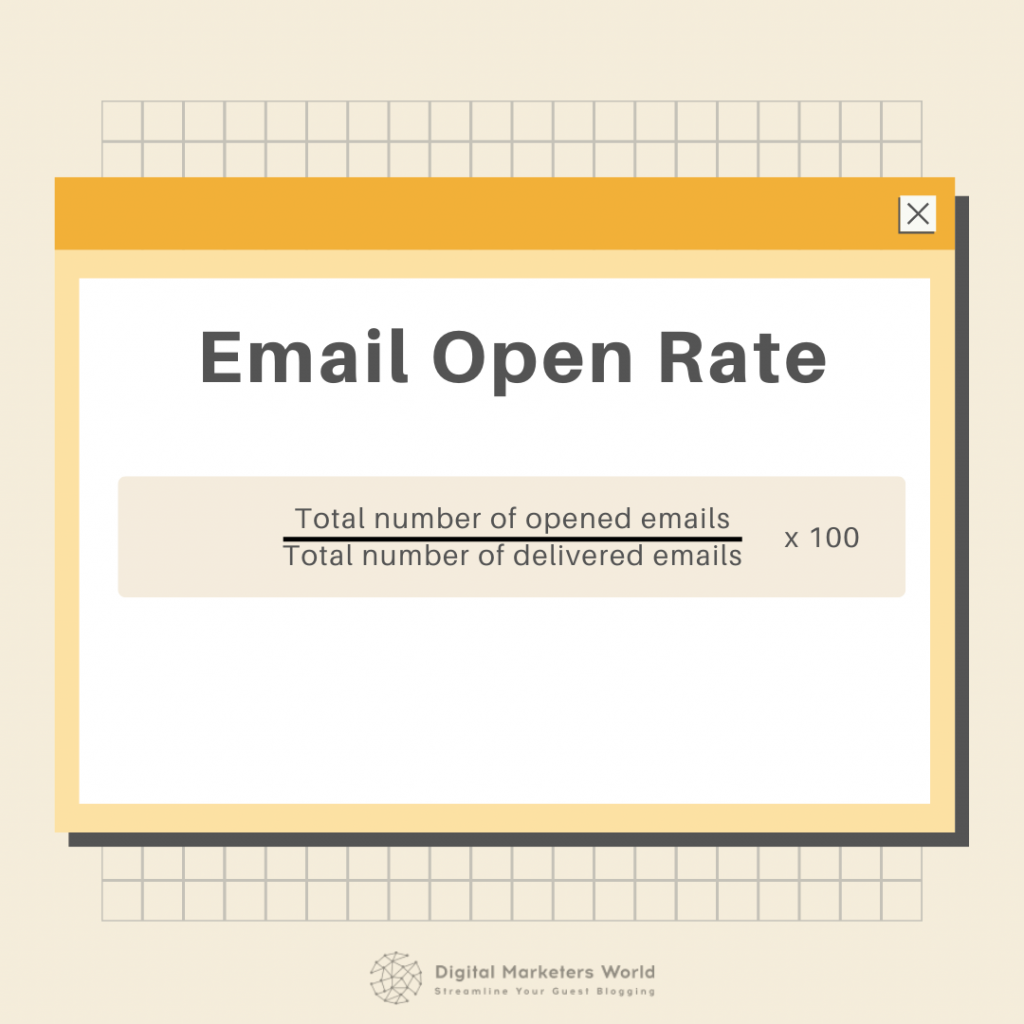
Many inexperienced marketers use this email KPI to determine the success of their campaigns. However, this metric only matters when reviewed together with others, like click-through rate or conversion rate. Also, it’s better to monitor how your open rate improves over time – if it does, it means your email marketing strategy is effective.
What factors can lower your email open rates?
If this is the case, you might want to optimize the following:
- Email delivery time. If the email appears in your subscriber’s inbox at the wrong time, chances are it will get lost among numerous other messages.
- Using public domain. If you’re sending your emails using Gmail, Outlook, Yahoo, and other email service providers, they have higher chances of ending up in the Spam folder.
- Absence of SPF and DKIM authentication methods. If you don’t apply these to your DNS settings, it can harm your sender reputation and impact open rates as a result.
- Email list age. If your list contains some inactive email addresses, the open rate will go down.
Some other reasons for low email open rates are concerned with email content, in particular, email subject lines, low personalization, or the “from” name the recipient can’t recognize.
Metric #2: CTR
Click-through rate (a.k.a CTR, email click rate) is the percentage of recipients who have clicked on an email link, a CTA, or an image within your email.
Here is the formula explaining how to calculate your click-through rate:

CTR is an engagement metric – it shows how active your subscribers are, and if tracked over time, it helps you understand how interested your audience is in receiving your emails.
Most ESPs calculate CTR using unique clicks. If a subscriber clicks on the link two times, the second time doesn’t count.
What is the average click-through rate among different industries?
The research by Campaign Monitor shows an average percentage of 2.3%. The industries that boast the highest CTR include agriculture, healthcare, real estate, design, and construction.
Now, what if your CTR is too low?
If this is your situation, you might want to check the following factors impacting this metric:
- Email opt-ins. Have you asked the subscriber for their consent to receive emails from you? If not, then the chances of them opening your message and clicking on the link are very low.
- Subject line. If it’s not personalized, too vague, or unreadable, the chances of receiving a click are insignificant.
- Email content. The value of the offer you make in an email should be clear to the recipient – they should understand clearly why it’s good for them to hit the CTA button.
- CTA placement. It should be located in several parts of the email and be noticeable enough for the subscriber. The text in the CTA button also matters.
By the way, if you run preliminary A/B testing before launching the campaign, it can positively impact your email CTR.
Metric #3: Bounce rate
The email bounce rate reflects the percentage of email addresses in your list that did not receive your message because it was returned by the subscriber’s mail servers.
Here’s how you calculate the bounce rate:
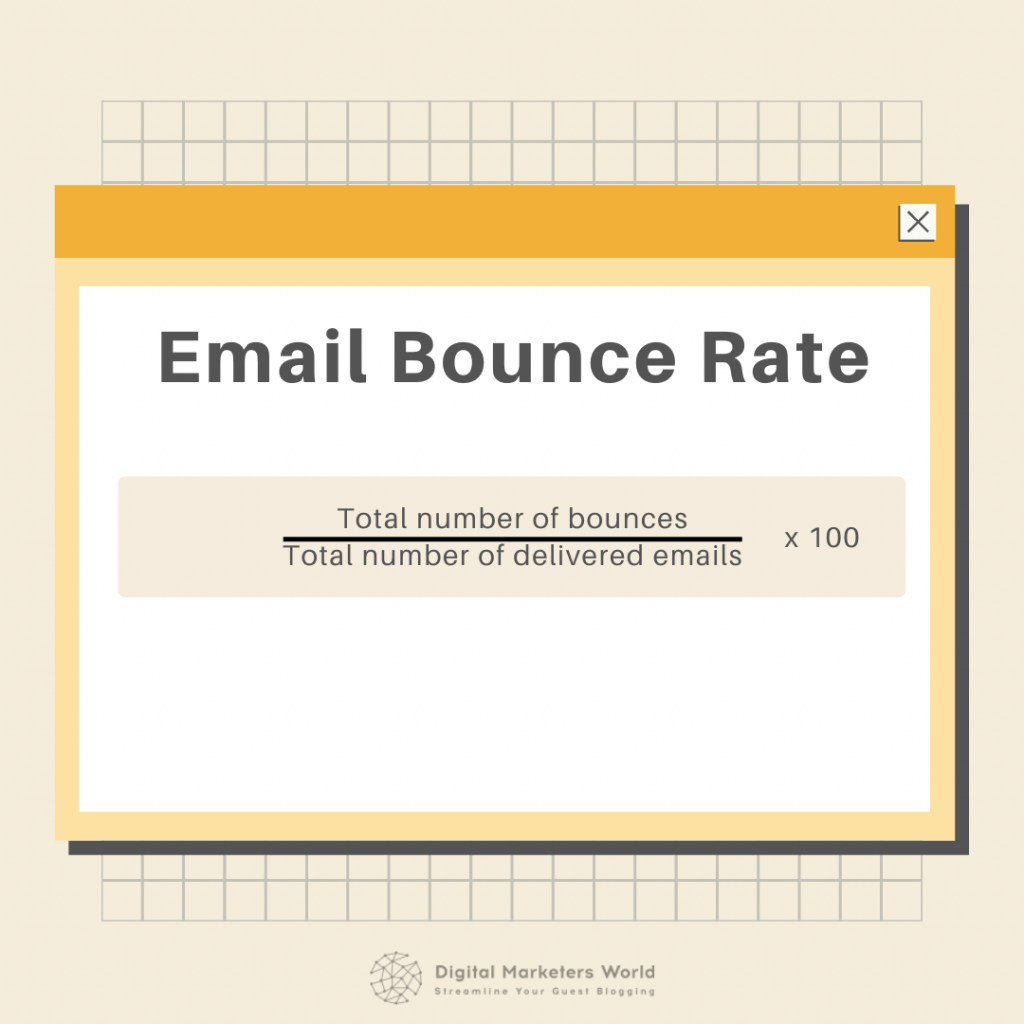
We already covered email bounce rates extensively in our guide, but let’s recap the key details.
There are two types of email bounces – hard bounce (email server doesn’t accept your email) and soft bounce (email server accepts your email, but it still returns to you). A hard bounce happens when you’re sending messages to invalid email addresses, the domain is outdated, or the email server blocks your IP. Soft bounces can occur if the recipient’s inbox is full, their mailbox is no longer active, the email server is down, or for other reasons.
If your email bounce rate is too high, you can reduce it with the following tactics:
- Avoid purchasing email lists – they often contain outdated email addresses.
- Update your subscriber list regularly – this is necessary to remove irrelevant emails.
- Personalize your emails – spammy content increases the chances of a bounce.
- Include opt-ins – if a subscriber agreed to receive your emails, the probability of a bounce will be lower.
- Don’t use free sender domains – they often don’t use sender authentication protocols.
Additionally, you might want to keep a close eye on your email subject lines – if they look spammy, your email may bounce.
Metric #4: Conversion rate
Email conversion rate (CR) is the percentage of email recipients who complete a required action. It can be subscribing to your newsletter, clicking the link to view a specific product, etc.
Here’s the formula to calculate the conversion rate:

Your CR mostly depends on how personalized your email is. If your offer is tailored to the needs of a specific subscriber and includes a lucrative offer, the chances are high that the recipient will click on, read through your email, and follow the call-to-action button in it.
Another important factor is email design. It should engage the reader, highlight the main perks of your offer, and make the CTA button visible enough for the recipient to notice and click on it. The message in the CTA button should also be straightforward and related to the idea behind the email. Apart from that, make sure that email design is optimized for mobile devices.
And, like with most situations related to email marketing, you need to run an A/B test to ensure a good delivery in terms of conversion rates.
Metric #5: Spam complaints
Email spam complaint rate is the percentage of people who flagged your emails as spam out of the total emails sent. This metric is essential to the performance of your email campaign.
The formula to calculate the spam complaint rate is the following:
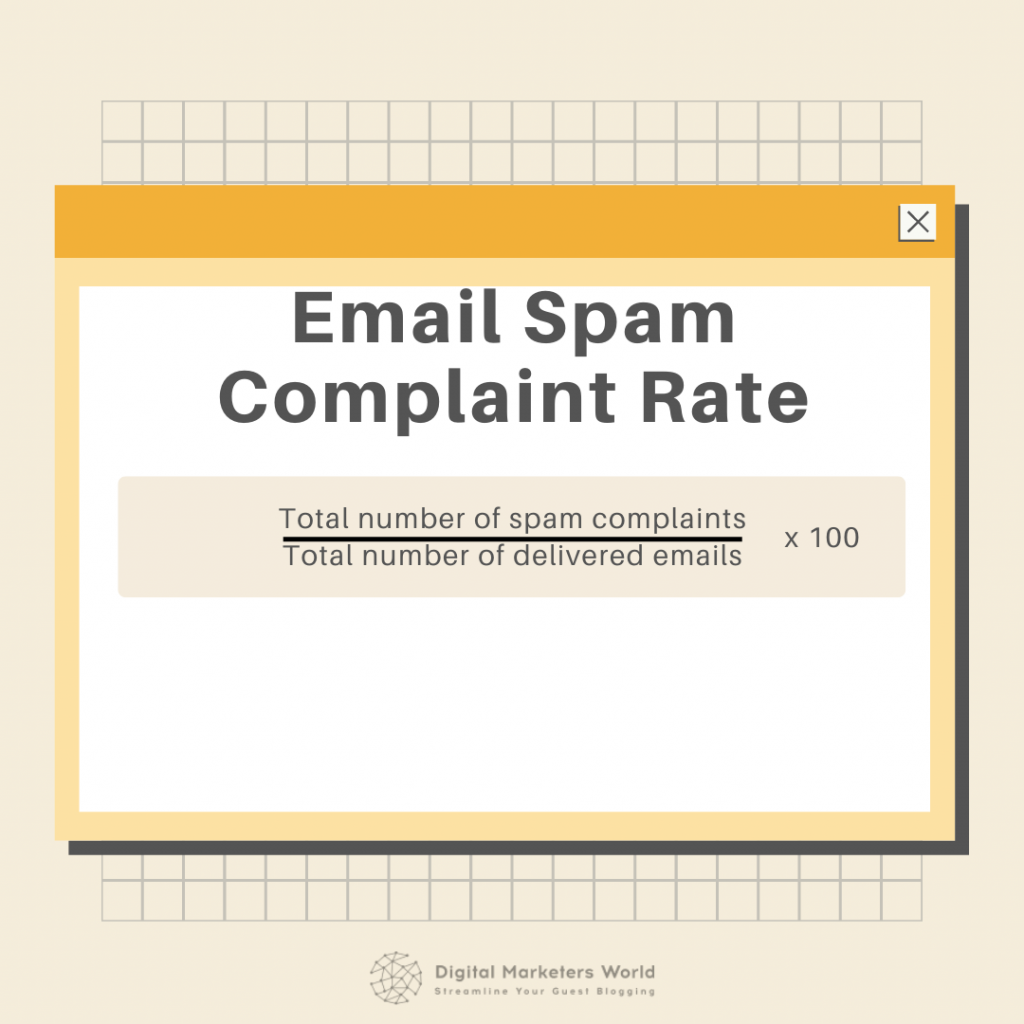
Spam complaints are collected by your email marketing platform through the algorithm called the feedback loop. When someone marks your letter as spam, your ESP sends you a notification and then calculates the overall spam rate out of all emails you’ve sent. You can also switch on the function to exclude such recipients from your email list automatically as they are clearly not interested in your emails. It is also done to prevent an increase in the unsubscribe rate.
Here’s what you can do to decrease spam complaints:
- Keep your email list permission-based
- Don’t buy email lists
- Create a custom domain
- Apart from email opt-ins, also allow email opt-outs.
- Make your “from” details in the subject line straightforward
- Bet on personalization
- Don’t send your emails too often
It’s also a good idea to let your subscribers know how often they will be receiving your emails. You don’t want to overwhelm their inboxes.
Over to You
We’re not going to deny it – email marketing can be hard to execute, it is definitely a trial-and-error process, and there is no perfect formula for it. Your email marketing strategy will differ from everyone else’s, but it doesn’t mean you can’t learn from their successes and mistakes.
Hopefully, this guide provides you with enough information about email marketing to get you started. However, make sure to stay tuned to more guides on this topic and check other gems on our blog!

Mariia is a content strategist and editor at Digital Marketer’s World. She is passionate about educating others on all things marketing and believes in the power of the written word.
